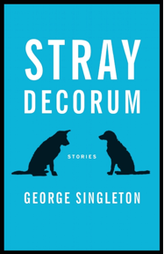According to George Singleton, the motto for the Southern States should read, “The land of the free and the home of the strays.” At least, that’s the picture he portrays in his new novel Stray Decorum. Decorum, Singleton’s fifth book, aims to capture the enchanting, yet bizarre, Southern disposition through a collection of eleven short stories – all centered around small-town South Carolina living. Contrary to the illustration on the front cover, Stray Decorum is not solely a collection of anecdotes about man’s best friend. Instead, it’s a quirky and often hilarious ensemble of tales about strays, both human and mammal, alike. The thematic notion of the South as a refuge for drifters rings clear throughout the collection, often mirrored through the actions of the characters as they “take in the strays.” It is almost an unwritten law that everyone takes care of each other – no matter how odd or imperfect.
For example, in the story titled, “A Man with My Number,” a door-to-door salesman visits Leonard Scott, a lonely, recently divorced, machete-collecting, nursery-owning hermit. The man claims to be selling stick-on address numbers for homes. Although Scott suspects that the numbers are stolen, he invites the salesman into his home. After a sales pitch and a few drinks, Scott confides in the man about his recent divorce, “My wife left me because she said I was too trusting.” The men develop a brief camaraderie and Scott decides to help the salesman by purchasing a few numbers. When the salesman leaves, Scott notices that a few pieces of jewelry are missing from his home. Too trusting, indeed. But there is a certain level of charm in Scott for wanting, almost instinctively, to take care of another, leaving no one behind. Another story titled, “Vaccination,” plunges the reader into the mind of Edward, a professional basket weaver with a knack for sarcasm, “What should a divorced basket weaver do when tempted by a microchip-believing hippie woman intent on drinking before noon?” In this line, Edward both pokes fun at his own unconventional lifestyle and celebrates it at the same time. He acknowledges the reader about his ridiculous dilemma, practically bragging about his ability to have such unusual options in his life. Throughout the collection, Singleton has an undeniable skill of building character depth quickly. By the second page of each story, the reader feels as though he has known each character for years. In an excerpt from “Vaccination” Singleton writes: I read somewhere that an older dog can overdose on all these vaccinations, and I have found – I share this information with every dog owner I meet – that if you keep your pet away from rabid foxes, raccoons, skunks, bats, and people whose eyes rotate crazy in their sockets, then the chances of your own dog foaming at the mouth diminish drastically. We have all met this person in some shape or form. The excessively cautious, all-knowing skeptic. Whether it is a friend, family member, or coworker, this person, as well as all of the other characters in the book, exists in every social circle. And it is precisely this familiarity of character that Singleton employs throughout the book to bring these stories close to home. Perhaps one downfall for this collection is that it gives the reader only a snippet of each character’s day. The endings of stories such as “A Man with My Number” leave the reader wondering what happens next. What happens after Scott realizes the jewelry is gone? Does he chase after the salesman? Or does he just let the man continue on his path of thievery? Unfortunately, answers to these questions could only be fleshed out in a longer, more centralized work. Although Singleton, a South Carolina native, playfully derides the Southern culture, his writing illustrates an endearing pride for the South as a haven for individuality and acceptance. These are the people that comprise the South – a bit rough around the edges, but also willing to lend a helping hand when necessary. Together, they give the South its personality.
0 Comments
Leave a Reply. |
Archives
April 2024
Categories
All
|
|
Glassworks is a publication of Rowan University's Master of Arts in Writing 260 Victoria Street • Glassboro, New Jersey 08028 glassworksmagazine@rowan.edu |
All Content on this Site (c) 2024 Glassworks
|


 RSS Feed
RSS Feed
